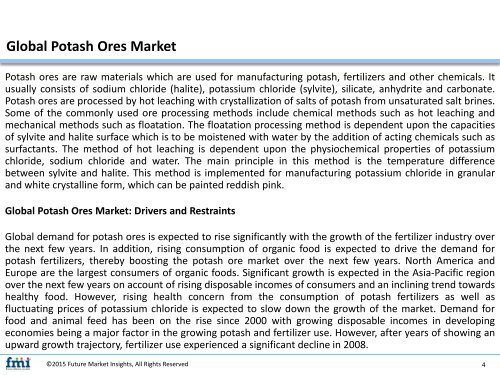Potash Ores Market Revenue, Opportunity, Forecast and Value Chain 2016-2026
Potash ores are raw materials which are used for manufacturing potash, fertilizers and other chemicals. It usually consists of sodium chloride (halite), potassium chloride (sylvite), silicate, anhydrite and carbonate. Potash ores are processed by hot leaching with crystallization of salts of potash from unsaturated salt brines. Some of the commonly used ore processing methods include chemical methods such as hot leaching and mechanical methods such as floatation. The floatation processing method is dependent upon the capacities of sylvite and halite surface which is to be moistened with water by the addition of acting chemicals such as surfactants. The method of hot leaching is dependent upon the physiochemical properties of potassium chloride, sodium chloride and water. The main principle in this method is the temperature difference between sylvite and halite. This method is implemented for manufacturing potassium chloride in granular and white crystalline form, which can be painted reddish pink. Request Free Report Sample@ http://www.futuremarketinsights.com/reports/sample/rep-gb-1493
Potash ores are raw materials which are used for manufacturing potash, fertilizers and other chemicals. It usually consists of sodium chloride (halite), potassium chloride (sylvite), silicate, anhydrite and carbonate. Potash ores are processed by hot leaching with crystallization of salts of potash from unsaturated salt brines. Some of the commonly used ore processing methods include chemical methods such as hot leaching and mechanical methods such as floatation. The floatation processing method is dependent upon the capacities of sylvite and halite surface which is to be moistened with water by the addition of acting chemicals such as surfactants. The method of hot leaching is dependent upon the physiochemical properties of potassium chloride, sodium chloride and water. The main principle in this method is the temperature difference between sylvite and halite. This method is implemented for manufacturing potassium chloride in granular and white crystalline form, which can be painted reddish pink.
Request Free Report Sample@ http://www.futuremarketinsights.com/reports/sample/rep-gb-1493
Create successful ePaper yourself
Turn your PDF publications into a flip-book with our unique Google optimized e-Paper software.
Global <strong>Potash</strong> <strong>Ores</strong> <strong>Market</strong><br />
<strong>Potash</strong> ores are raw materials which are used for manufacturing potash, fertilizers <strong>and</strong> other chemicals. It<br />
usually consists of sodium chloride (halite), potassium chloride (sylvite), silicate, anhydrite <strong>and</strong> carbonate.<br />
<strong>Potash</strong> ores are processed by hot leaching with crystallization of salts of potash from unsaturated salt brines.<br />
Some of the commonly used ore processing methods include chemical methods such as hot leaching <strong>and</strong><br />
mechanical methods such as floatation. The floatation processing method is dependent upon the capacities<br />
of sylvite <strong>and</strong> halite surface which is to be moistened with water by the addition of acting chemicals such as<br />
surfactants. The method of hot leaching is dependent upon the physiochemical properties of potassium<br />
chloride, sodium chloride <strong>and</strong> water. The main principle in this method is the temperature difference<br />
between sylvite <strong>and</strong> halite. This method is implemented for manufacturing potassium chloride in granular<br />
<strong>and</strong> white crystalline form, which can be painted reddish pink.<br />
Global <strong>Potash</strong> <strong>Ores</strong> <strong>Market</strong>: Drivers <strong>and</strong> Restraints<br />
Global dem<strong>and</strong> for potash ores is expected to rise significantly with the growth of the fertilizer industry over<br />
the next few years. In addition, rising consumption of organic food is expected to drive the dem<strong>and</strong> for<br />
potash fertilizers, thereby boosting the potash ore market over the next few years. North America <strong>and</strong><br />
Europe are the largest consumers of organic foods. Significant growth is expected in the Asia-Pacific region<br />
over the next few years on account of rising disposable incomes of consumers <strong>and</strong> an inclining trend towards<br />
healthy food. However, rising health concern from the consumption of potash fertilizers as well as<br />
fluctuating prices of potassium chloride is expected to slow down the growth of the market. Dem<strong>and</strong> for<br />
food <strong>and</strong> animal feed has been on the rise since 2000 with growing disposable incomes in developing<br />
economies being a major factor in the growing potash <strong>and</strong> fertilizer use. However, after years of showing an<br />
upward growth trajectory, fertilizer use experienced a significant decline in 2008.<br />
©2015 Future <strong>Market</strong> Insights, All Rights Reserved 4

















